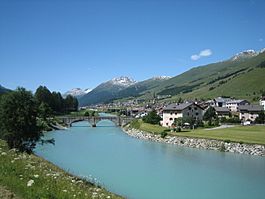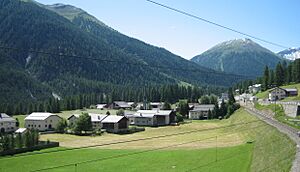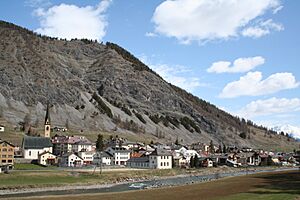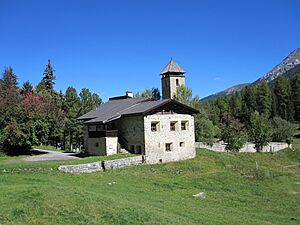S-chanf facts for kids
Quick facts for kids
S-chanf
|
||
|---|---|---|
 |
||
|
||
| Country | Switzerland | |
| Canton | Graubünden | |
| District | Maloja | |
| Area | ||
| • Total | 138.04 km2 (53.30 sq mi) | |
| Elevation | 1,660 m (5,450 ft) | |
| Population
(Dec 2020 )
|
||
| • Total | 697 | |
| • Density | 5.049/km2 (13.078/sq mi) | |
| Postal code |
7525
|
|
| Surrounded by | Bergün/Bravuogn, Davos, Livigno (IT-SO), Madulain, Susch, Zernez, Zuoz | |
S-chanf is a small town, also called a municipality, in the Maloja Region of Switzerland. It is located in the Swiss canton of Graubünden.
The municipality of S-chanf includes smaller areas like Susauna, Chapella, and Cinuos-chel.
Contents
About the Name
The name S-chanf was first written down around 1137–1139 as Scaneves. Later, in 1356, it was called Scanevo. The German name Scanfs was used officially until 1943.
Chapella is a place where a chapel was first mentioned in 1209. Susauna was called Sauzana in 1285.
Geography and Landscape
S-chanf covers an area of about 138 square kilometers (53 square miles). A good part of this land, about 23.7%, is used for farming. Forests cover 18.6% of the area.
Only a small part, 0.6%, has buildings or roads. The rest, a large 57.1%, is made up of natural features like rivers, glaciers, or mountains.
S-chanf is located along the Inn river. It is also near the start of the Casanna pass. The village itself is about 1,662 meters (5,453 feet) above sea level.
Susauna is a small village within S-chanf. It sits on the road to Scaletta Pass, which was an important trading route long ago.
Population and People
In 1850, S-chanf had 439 people, and they all spoke the Romansh language. The number of people went down to 402 by 1900. But then it grew again to 460 by 1950.
Today, S-chanf has a population of about 700 people. Around 11.4% of the people living here are from other countries. Over the last ten years, the population has grown by about 7.5% each year.
Age Groups
In 2000, about 10.6% of the people in S-chanf were children aged 0 to 9. Teenagers (10-19 years old) made up about 14.8% of the population.
Adults aged 20 to 59 made up about 56.1% of the population. Older adults (60-99 years old) made up about 18.4%.
Education and Jobs
Many adults in S-chanf (between 25 and 64 years old) have completed higher education. This means they went to a university or a special college.
S-chanf has a low unemployment rate, which means most people who want to work can find jobs. Many people work in farming, manufacturing, or service jobs like hotels and shops.
Languages Spoken
Most people in S-chanf speak Romansh, which is a local language. About 51.8% of the population speaks Romansh. German is the second most common language, spoken by 37.3% of the people. Italian is spoken by 5.6%.
Until the mid-1800s, almost everyone in S-chanf spoke Romansh. But as the town connected more with the outside world, other languages became more common. Even so, about 68% of the people can still understand Romansh.
| Languages | Census 1980 | Census 1990 | Census 2000 | |||
|---|---|---|---|---|---|---|
| Number | Percent | Number | Percent | Number | Percent | |
| German | 74 | 16.02% | 129 | 25.60% | 231 | 37.26% |
| Romansh | 344 | 74.46% | 336 | 66.67% | 321 | 51.77% |
| Italian | 26 | 5.63% | 27 | 5.36% | 35 | 5.65% |
| Population | 462 | 100% | 504 | 100% | 620 | 100% |
Tourism and Activities
S-chanf is a great starting point for exploring the Swiss National Park. This park is a special place where you can only walk, and it's full of amazing wildlife. If you visit early in the morning, you might see marmots or even ibex high up in the mountains.
The town has hotels like the Aurora and the Scaletta, where visitors can stay.
S-chanf is also famous as the finish line for the "Engadin Skimarathon". This is a very popular cross-country ski race that covers a long distance, starting in Maloja.
The town is also home to a base for the Swiss Air Force. They have an area there for target shooting practice.
Historic Buildings
There are some old and important buildings in S-chanf. For example, the twin homes and barn at Nrs. 216/217 and the home with barn at Nr. 107 are considered important Swiss heritage sites.
The hospice at La Chapella was built around 1250. A hospice was a place that offered shelter to travelers. It was closed in the late 1700s but reopened in 1967 as a youth center.
The chapel in Susauna was built in 1696. It used to have its own pastors. Today, it is mostly used only during certain seasons.
Getting Around
S-chanf has two train stations: S-chanf and Cinuos-chel-Brail. These stations are on the Bever–Scuol-Tarasp line. You can take trains from here to other towns like St. Moritz, Landquart, Scuol-Tarasp, and Pontresina.
Images for kids
See also
 In Spanish: S-chanf para niños
In Spanish: S-chanf para niños








